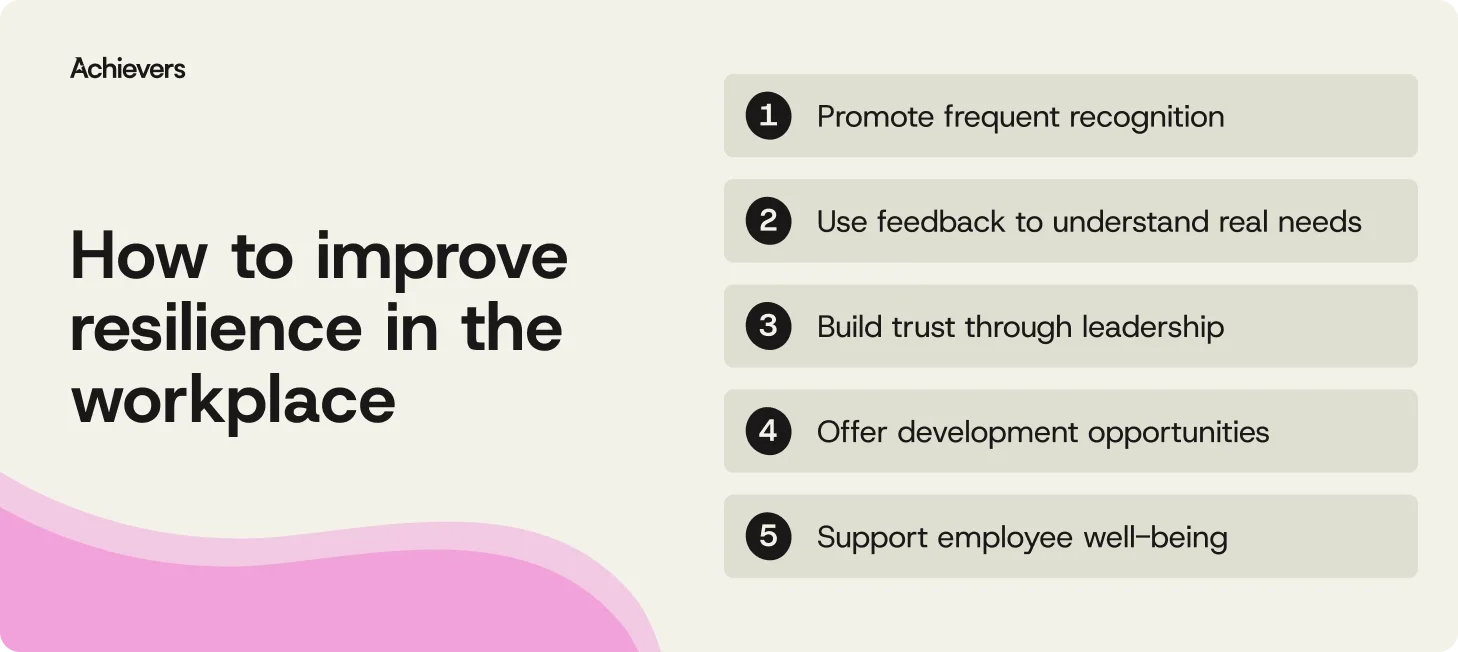Table of contents
Create a culture that means business™
Schedule a demo with an Achievers solution expert today.
Resilience in the workplace is what keeps teams grounded when everything else is shifting — whether it’s new tools, new goals, or just another “quick pivot.” It’s the ability to adapt, manage stress, and keep going without burning out — all while staying productive and protecting well-being.
But resilience doesn’t come out of nowhere. It’s built through strong support systems, a culture that values effort as much as outcomes, and frequent recognition that reminds people their work matters, especially when things get hard.
So what does real resilience look like at work? And how can organizations actually build it, not just talk about it? Let’s dig in.
5 strategies for improving resilience in the workplace
You can’t schedule resilience into the calendar or add it to your tech stack — but you can create the conditions for it to grow. Building resilience at work means going beyond buzzwords and stress ball giveaways. It’s about shaping an environment where employees feel supported, seen, and equipped to handle whatever the workday throws their way.
Here are three ways to make that happen:

1. Promote frequent employee recognition
When times are tough, appreciation shouldn’t be the first thing to go — it should be the first thing you double down on. A quick “you’ve got this” or a public shoutout might seem small, but those moments fuel morale and momentum. And the data backs it up. According to Achievers Workforce Institute (AWI), employees who are meaningfully recognized at least once a month are 91% more likely to be highly engaged and 84% more likely to say they’re working at their best.
The key is consistency. Train your leaders to recognize often and meaningfully. Give your people the tools to celebrate wins, big or small, in real time. Invest in a social, points-based recognition platform to turn appreciation into habit, helping resilience spread across teams like, well, recognition.
2. Use employee feedback to understand real needs
You can’t fix what you don’t see. And employees can’t be expected to power through challenges if no one’s paying attention. That’s why resilient organizations keep a constant pulse on how people are feeling — not just once a year, but all year long.
Whether it’s quick surveys, anonymous feedback tools, or an AI-powered chatbot that checks in between meetings, give your team simple ways to speak up. Then do something with what you learn. Real resilience starts when employees know their voice counts — and when leadership shows up with action, not just good intentions.
3. Build trust through empowering leadership
Here’s the thing about micromanagement: it doesn’t build strong teams — it builds burnout. It fuels a quiet quitting culture. When leaders focus on empowering employees instead of hovering over them, people feel trusted, capable, and more willing to take risks (the good kind).
Resilient workplaces aren’t rigid. They’re built on clarity, encouragement, and room to grow. That means giving employees space to problem-solve, recognizing their efforts along the way, and keeping communication open when things go sideways. Trust fuels confidence, and confident teams don’t crumble under pressure.
4. Offer development opportunities that build resilience
Resilient employees don’t just wing it — they’ve got the skills to navigate change with confidence. Organizations that invest in development programs focused on adaptability, problem-solving, and emotional intelligence give employees the tools to stay steady when things shift.
And when learning is paired with appreciation, it sticks. In fact, AWI data says 82% of employees who are recognized at least monthly say they feel supported in achieving their development goals. Whether it’s a leadership course, microlearning module, or peer coaching, employee development shouldn’t be an afterthought — it’s fuel for confidence, and confidence is key to resilience.
5. Support employee well-being to reduce stress and burnout
Burnout doesn’t build resilience — it breaks it. That’s why resilient cultures create space for recovery, not just productivity. Encouraging time off, modeling healthy boundaries, and offering wellness resources are all part of the equation. But so is building a workplace where people feel safe asking for help and supported when they do.
Recognition can help here, too. Not just for outcomes, but for effort, teamwork, and showing up on tough days. Because resilience thrives where people feel valued and human, not superhuman.
What resilience in the workplace looks like in real life
Resilience shows up in the steady effort — staying focused, staying calm, and finding a way forward when things get tough. When those moments are recognized, they don’t just lift spirits — they help build a culture where resilience sticks.
Here’s how resilience shows up in everyday workplace moments, and why it’s worth celebrating when it does:
- Staying focused under pressure: When a deadline’s closing in, resilient employees stay grounded. They sort through what matters most, ask for help when needed, and still get the job done. A quick thank-you from a manager or peer can give them the boost to keep going strong.
- Embracing new tools and tech: New software or processes? Resilient employees lean in, not back. They adapt quickly, help others along the way, and see change as a chance to grow. Recognizing that mindset helps build a culture that’s curious, capable, and ready for what’s next.
- Stepping up during staff shortages: When headcount dips, resilient teams don’t shut down — they show up. They take on extra responsibilities, support one another, and find creative ways to keep things moving. And while that kind of effort is impressive, it shouldn’t go unnoticed. The reality is that 41% of employees say feeling recognized helps them better manage a heavy workload, according to AWI — proof that even a small thank-you can go a long way.
- Learning from failure: Not every project is a win, but resilient employees don’t get stuck in the loss. They analyze what went wrong, pull out the lessons, and apply them the next time around. A recognition culture that highlights effort and learning (not just success) makes it easier for people to take smart risks and recover quickly.
- Taking feedback in stride: Resilient employees see feedback for what it is — a chance to grow. They take it in with an open mind, make thoughtful changes, and keep moving forward. When that progress is recognized, it helps build a culture where learning feels supported, not scary.
- Keeping morale up during change: When reorganizations or strategy shifts roll in, resilient employees help steady the team. They stay open, keep communication flowing, and look for ways to make a difference. Recognition tools that make it easy to send a timely, personal thank-you or shoutout can bring a much-needed lift when things feel uncertain.
- Resolving conflict with care: Disagreements happen. Resilient teams don’t avoid them — they handle them with calm, clarity, and a focus on finding common ground. Encouraging peer-to-peer recognition helps highlight those behind-the-scenes moments of teamwork that keep trust and collaboration intact.
- Balancing personal challenges and professional duties: Life doesn’t pause for work. Resilient employees find ways to show up, even when they’re navigating personal challenges. They ask for support when they need it — and keep things moving forward. A culture that recognizes the full person behind the role creates space for that balance to happen.
How recognition helps build resilience in the workplace
The most resilient teams don’t power through — they lean in. They adapt to change, lift each other up, and keep moving forward with purpose. Building resilience in the workplace isn’t about pushing people harder. It’s about giving them the trust, tools, and support to navigate whatever comes next — and come out stronger.
So, where does recognition fit in?
It’s the steady drumbeat that keeps people going. When employees feel seen — not just for big wins, but for effort, growth, and grit — they’re more likely to stay engaged, bounce back faster, and support others along the way. Build recognition into your culture, and resilience doesn’t just happen — it becomes how your team works.



